Naturally Leavened Sourdough Doughnuts
Naturally leavened, this sourdough doughnut recipe takes time and care but the end result makes the most amazing fried doughnuts.
Whether you call them doughnuts or sourdough donuts, they are soft and fluffy with a slight sourdough tang and coated in cinnamon sugar. The doughnuts need their time to rise and ferment but the end result is well worth the wait.
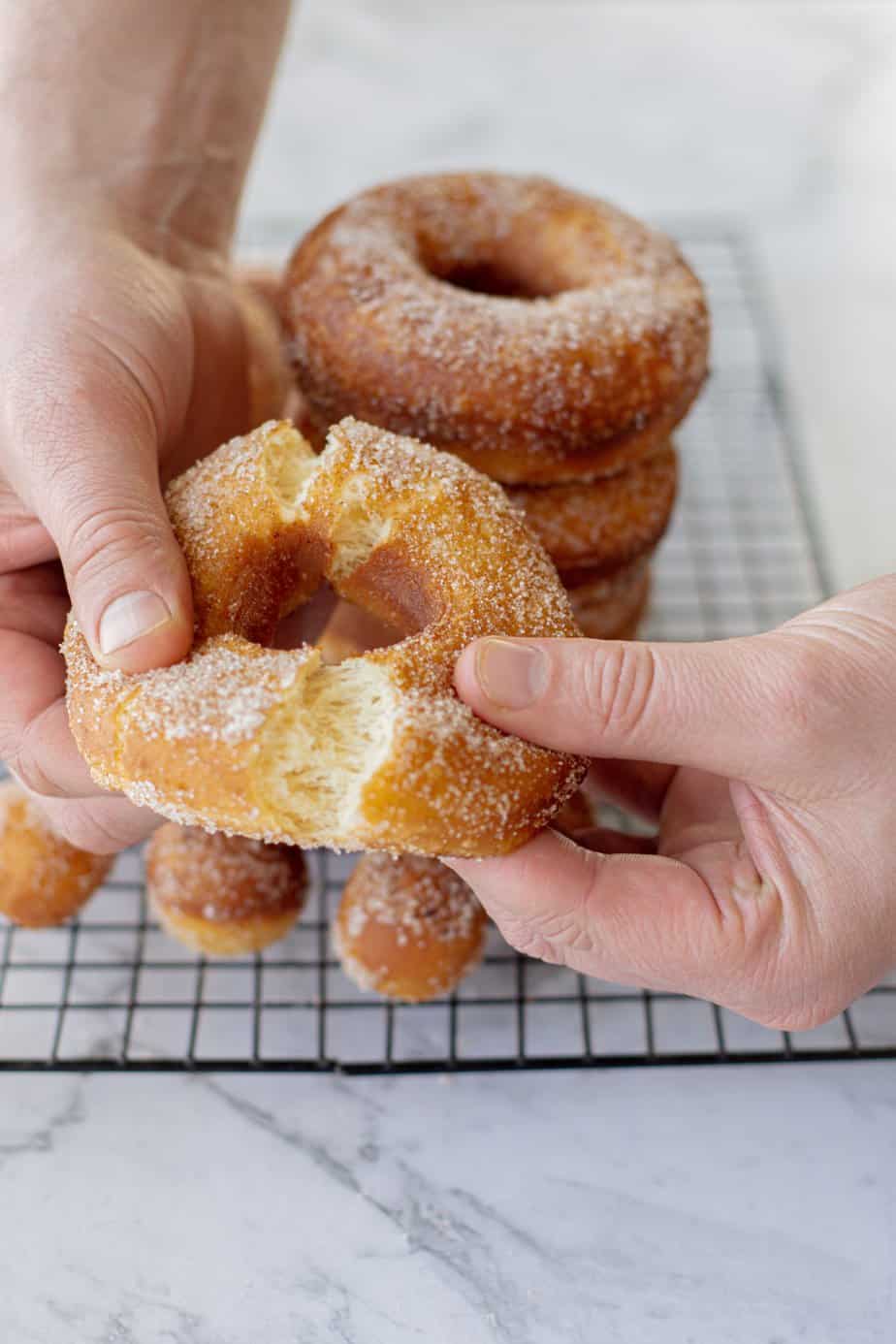
What are sourdough doughnuts?
Sourdough doughnuts are a tasty treat made from naturally leavened dough that has fermented slowly without any commercial yeast. The dough is given ample time to rise which creates a fluffy and light doughnut.
The dough in this sourdough doughnut recipe is enriched with eggs and butter for texture and flavour. The homemade donuts are fried to create a golden exterior and the inside remains soft and fluffy.
If you want a faster commercial yeast version, check out these vanilla custard doughnuts!

The sourdough starter
The active sourdough starter for these sourdough-leavened doughnuts is a stiff starter.
Stiffer starters are slower to rise than those with higher hydration. They undertake a slow but steady growth, with less risk of peaking too early. This is very helpful in an enriched dough which is always slower to rise. The first thing to do for this recipe is to feed the starter.
Use your 100% hydration sourdough starter, and feed part of it at the stiffer ratio.
The stiff starter is fed at a 1:2:1 ratio – 1 part starter, 2 parts flour, 1 parts water. This is measured in weight. A starter like this can take around 8-12 hours to rise, so it is fed the night before beginning the doughnut dough.
It makes a little dough ball of starter. Place this into a lightly oiled jar. Brush the top of the ball dough with a little water (so it doesn’t dry out too much overnight). Loosely cover with a lid and leave it to rise for 8-12 hours until more than doubled and domed on top.
If you don’t have a starter yet, learn to make your own sourdough starter with this step-by-step starter guide.
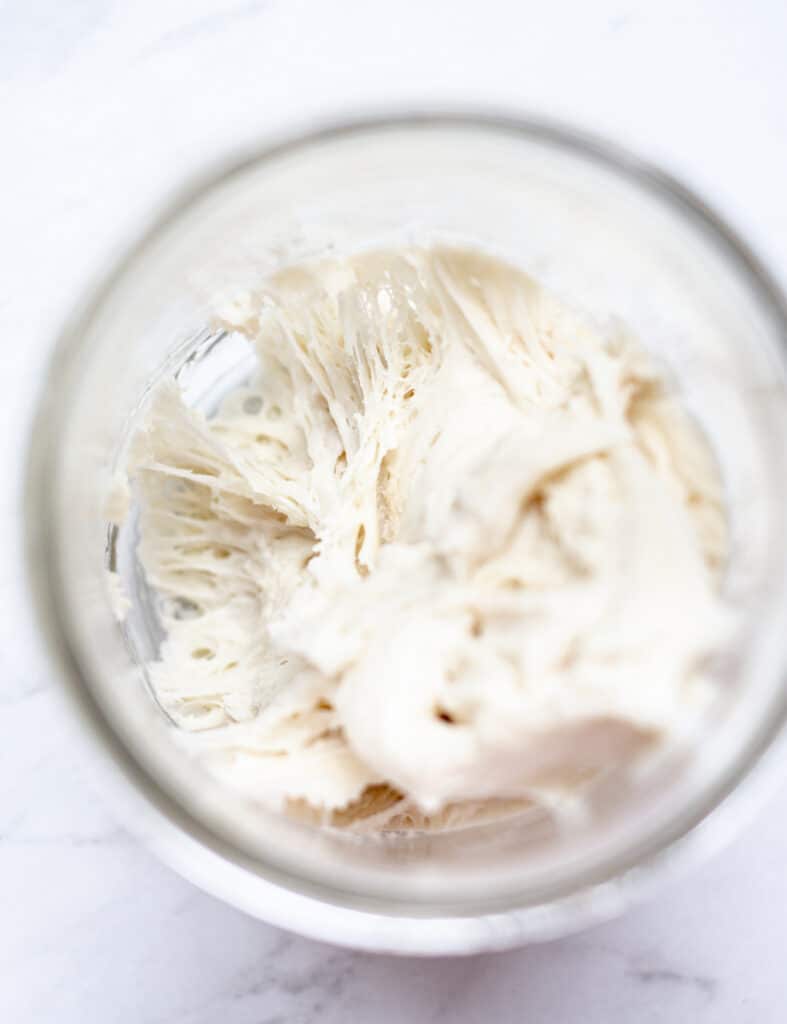
Baker’s Schedule
The night before – Feed your stiff sourdough starter
Day 1 – Mix the sourdough doughnut dough. Bulk ferment in a warm spot for approximately 4 hours until it has bulked out by 50%. Cover and refrigerate overnight.
Day 2 – Roll out the dough and cut it into doughnuts. Proof in a warm spot for approximately 4 hours until puffed and bulked out by around 50%. Fry the doughnuts.
Equipment
- Deep fryer or deep saucepan
- Deep frying thermometer
- Doughnut cutter or rings (two different sizes. One ring to cut the doughnut and one smaller ring to cut the doughnut hole. Jar lids work well for this)

Ingredients
Here are the dough ingredients needed in this sourdough doughnut recipe. The amounts are printed on the recipe card at the bottom of this post.
- Sourdough starter
- All-purpose flour. Use an all-purpose flour with a protein level of around 11.5% (depending on the brand of flour.) This protein content is enough to develop the gluten but not too much that the donut becomes chewy. In NZ this is our high-grade flour.
- Eggs
- Sugar
- Butter
- Salt
- Water
- Vegetable oil for frying
- Cinnamon and granulated sugar for coating
Step by Step
Step 1 – Feed the sourdough starter
The night before, feed the stiff sourdough starter. Take 30g sourdough starter (at 100% hydration) and feed it 60g flour and 30g water. Knead it slightly into a little dough ball and place it in a jar or glass.
Brush the top of the ball dough with a little water (so it doesn’t dry out too much overnight). Loosely cover with a lid and leave it to rise for 8-12 hours until more than doubled and domed on top.
Step 2 – Knead the dough
The next day it is time to mix the sourdough doughnut dough.
In a bowl of your stand mixer fitted with a dough hook attachment, combine the flour, eggs, vanilla extract, sugar, salt, water, and all the stiff starter. Turn the mixer on low and combine until it forms a thick and sticky dough. Keep mixing it for a couple of minutes to begin developing the gluten.
Slowly add in the room temperature butter, piece by piece, and continue mixing.
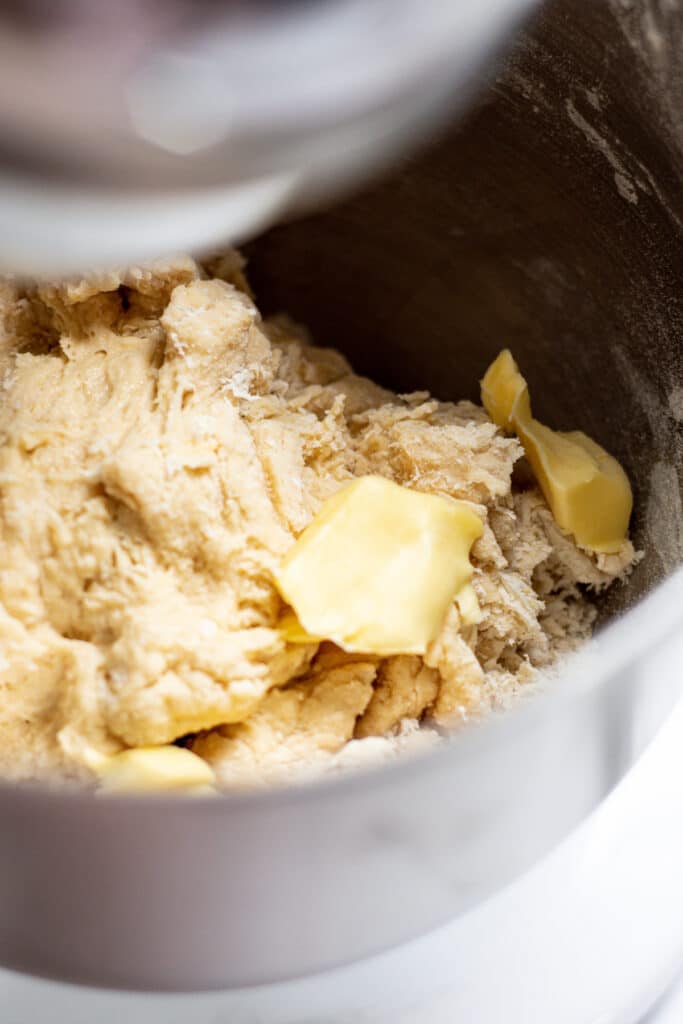
Turn the mixer on low and combine until it forms a thick but slightly sticky dough. Keep mixing for around 15 minutes until the dough is smooth, glossy, and elastic.
Leave the dough to sit for 5 minutes, then break off a piece and see if it can stretch out really thin without tearing. This is called the windowpane test and is a good way to see that the gluten has developed.
If mixing by hand, tip the dough ball onto a clean bench and slap and fold it for approximately 10 minutes, then let it rest for 10 minutes and come back to it and keep kneading until glossy and strong.
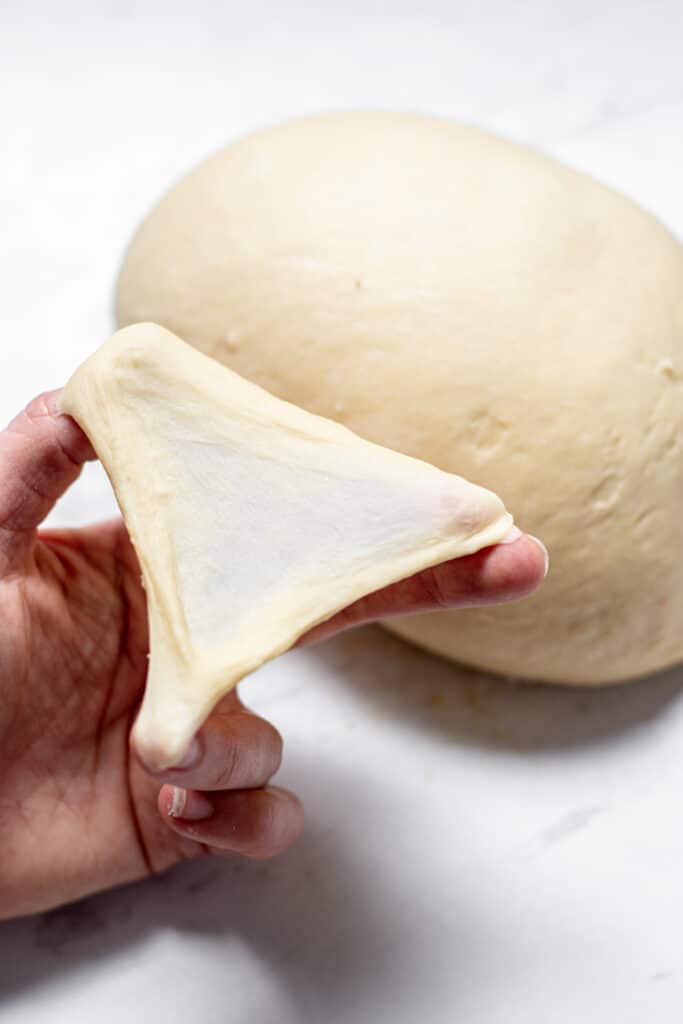
Step 3 – Bulk Fermentation (the first rise)
Place the kneaded dough in a lightly greased bowl and cover with a dampened tea towel, an upside-down plate, or plastic wrap.
Let the dough bulk ferment in a warm spot (ideally at around 26°C/78°F), for approximately 4 hours until it has bulked out by 50%. You can create a warm spot in a turned-off oven by placing a cup of water that has been boiled next to the bowl of dough. This step is important – don’t rush the rising.
Cover and refrigerate the dough overnight. It will rise a bit more in the fridge.
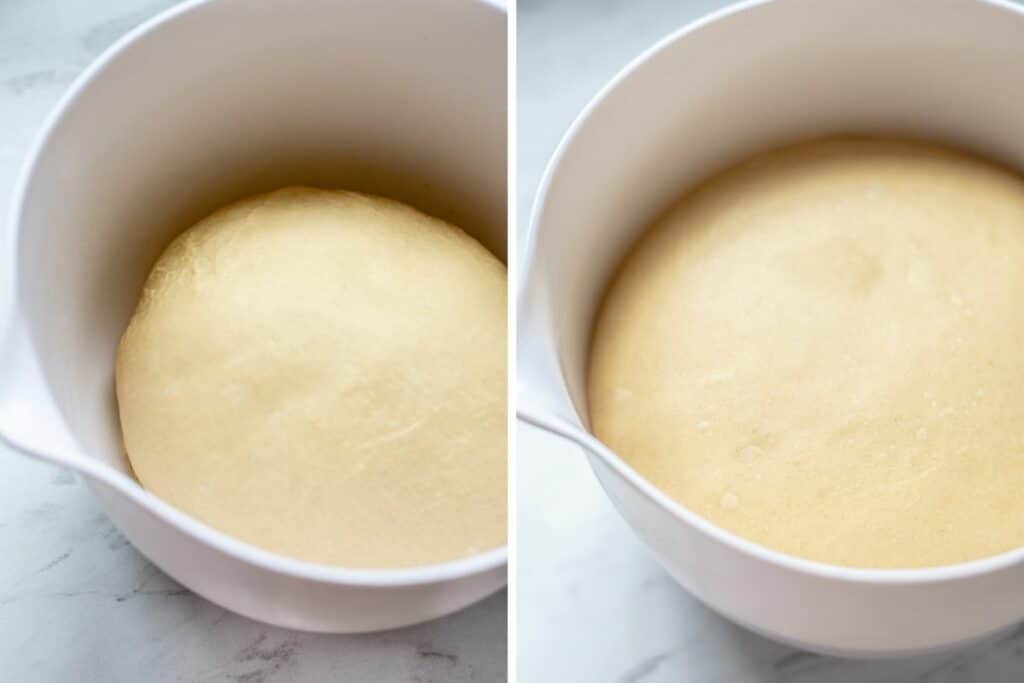

Step 4 – Cutting the doughnuts
The following day, remove the dough from the fridge and pull it from the bowl onto a work surface dusted with a little flour.
Roll the dough into a rectangle of about 1cm (2/5 inch) thickness. Cut out doughnut shapes using doughnut cutters, or biscuit cutter (cookie cutter), or use a large mason jar band and a really small jar lid or band for the middle doughnut hole.
Any leftover dough can be rolled out and cut again.
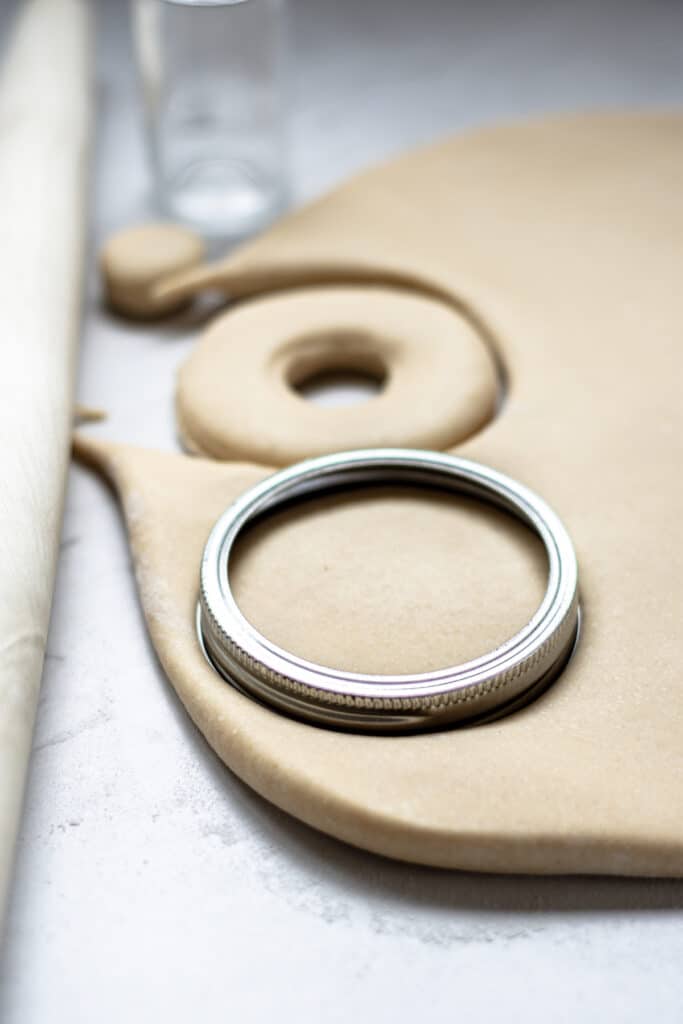
Step 5 – Proof the doughnuts
Place the cut doughnuts onto parchment paper or silicone baking sheets on baking trays and let them proof in a warm spot (ideally around 26°C/78°F) for anywhere around 4-6 hours until they have bulked out by at least 50%. This timing will change depending on your room temperature.
An oven that is off but with the light on makes a good proofing spot. Placing a mug of boiled water in the oven alongside the doughnuts keeps it slightly humid in there and stops them from drying out.
Alternatively, the trays can be covered with plastic wrap. If using plastic wrap, a home-compostable one is a more eco-friendly option.
Don’t rush this proofing step or your doughnuts will be dense.
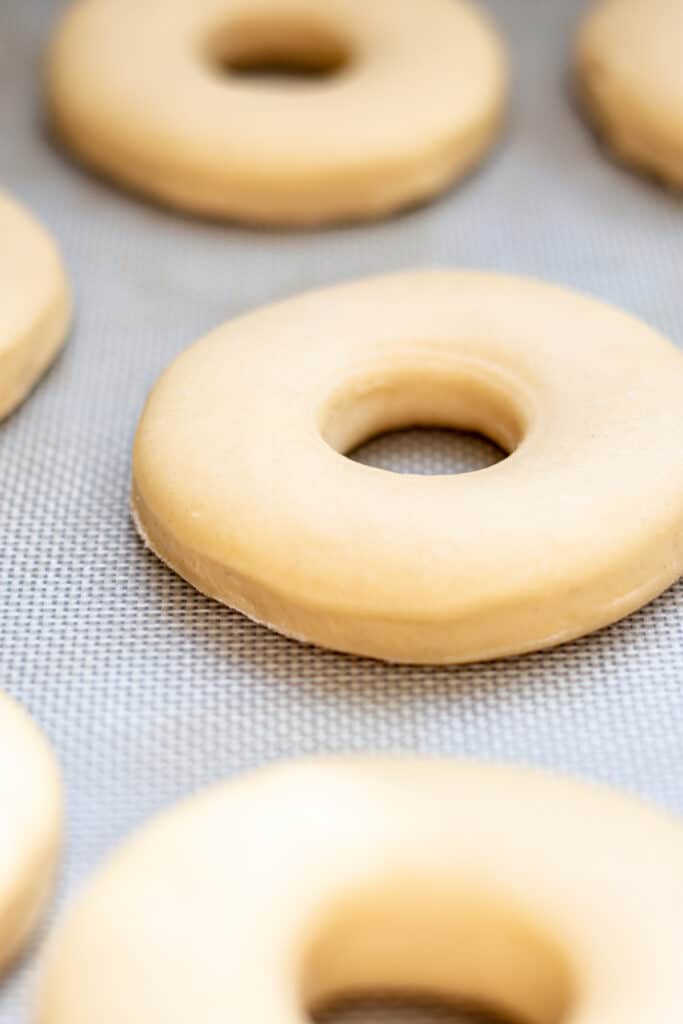
Step 6 – Frying
When the doughnuts have risen enough, pour the frying oil into a deep fryer or a deep pot and heat it to 347°F / 175°C.
If you’re not using a deep fryer (which usually comes with a thermometer) you’ll need a candy thermometer for this. One that can handle reading a high temperature.
Place the sugar and cinnamon for the topping in a bowl and set it aside.
Fry the doughnuts only 2-3 at a time in the hot oil, depending on the size of your pot. Don’t add too many at a time because they will lower the oil temperature. If it drops too much your doughnuts won’t fry well and will absorb too much oil.
Take care when handling the uncooked doughnuts as they are very delicate.
Fry them for around 1 1/2 – 2 minutes on each side until deep golden brown. It will be less for the smaller doughnut holes.
Ensure the oil in the pot stays hot, but don’t let the temperature of the oil surpass 356°F / 180°C or the doughnuts will burn before they have a chance to cook in the middle.

Step 7 – Coating the doughnuts
After frying, use a slotted spoon to remove the doughnuts from the oil, let them drip for a few seconds then place them while hot, into the sugar bowl.
Use tongs or two forks to flip the doughnuts in the sugar to coat them on all sides. Place the cinnamon sugar doughnuts on a cooling rack, then repeat the process with the remaining doughnuts.
Alternatively, the sourdough donuts can be tossed in powdered sugar instead of cinnamon sugar.

Serving and storing
The doughnuts are best eaten on the day they are made. If you don’t want to fry them all in one go, the shaped and proofed doughnuts can be refrigerated overnight again though this will increase their sourness.
Fried doughnuts can be covered and stored at room temperature for up to 3 days. They may firm up after a couple of days but they can be softened again in the microwave on LOW.
Freezing – You can freeze both the fried doughnuts and the dough. For the fried doughnuts, wrap them tightly or store them in an airtight container and freeze them for up to three months.
For the uncooked dough, cut out the doughnuts and let them rise. Once risen, transfer them to the freeze in a single layer and freeze them until solid. After this, they can be stored in airtight containers or bags in the freezer for up to 3 months. Let them defrost totally in the fridge before frying them.
Serving size
This sourdough doughnut recipe makes approximately 12 doughnuts and 12 doughnut holes.
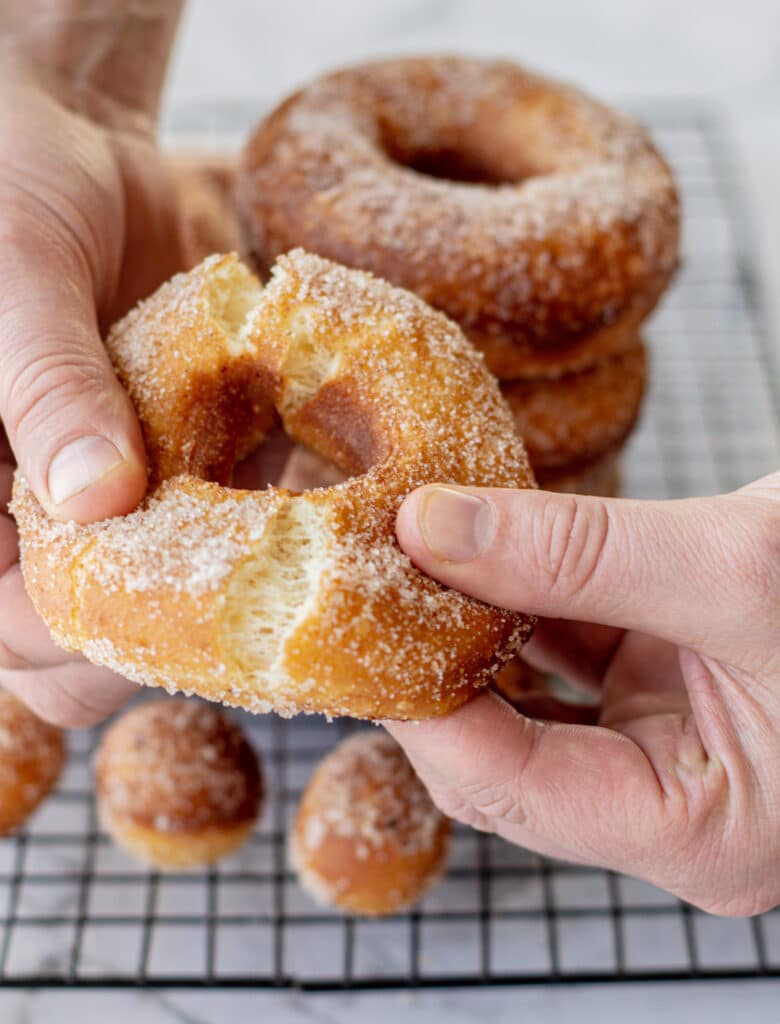
Doughnut FAQs
Can I freeze the doughnuts once they’ve been fried?
Yes, once cooled wrap them tightly or store them in an airtight container and freeze them for up to three months.
Is it better to use all-purpose flour or bread flour?
Bread flour will make a much chewier doughnut. All-purpose with a protein level of around 11.5% or all-purpose mixed with bread flour will work best.
Can I bake these doughnuts?
No, these need to be fried. Here are baked doughnuts.
More sourdough recipes
Here are some other sourdough recipes to try!
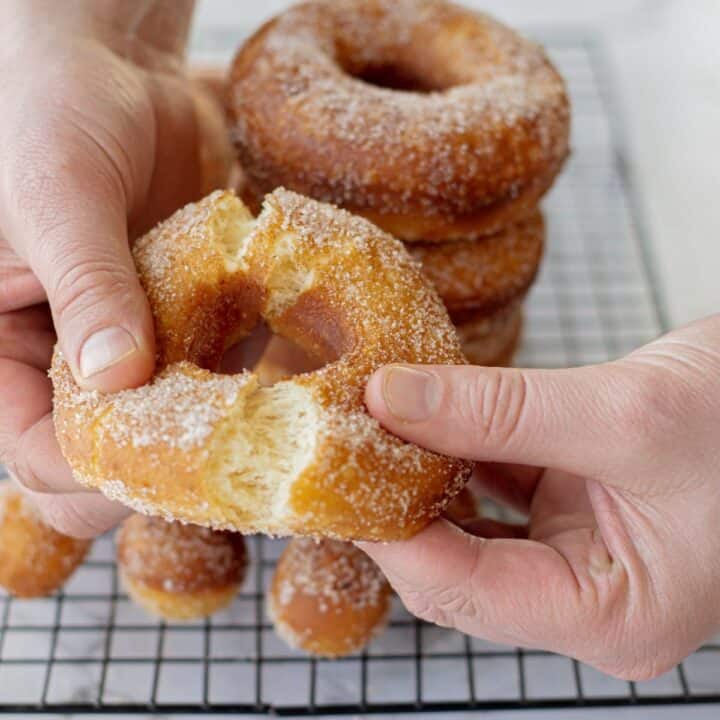
Sourdough Doughnuts
Naturally leavened, this sourdough doughnut recipe takes time and care but the end result makes the most amazing fried doughnuts.
Makes approx 12 doughnuts + 12 doughnut holes.
Ingredients
Stiff Sourdough Starter
- 30g starter
- 60g all-purpose flour
- 30g water
Dough
- 450g all-purpose flour with protein of around 11.5%
- 120g water
- 60g granulated sugar
- 2 large eggs
- 1 tsp vanilla extract
- 1 tsp salt
- All the stiff starter
- 60g butter, room temperature, cut into pieces
Frying and Coating
- 1-2 litres vegetable oil
- 1 cup granulated sugar
- 2 tsp ground cinnamon
Instructions
The night before
- Combine the ingredients for the stiff starter. It makes a little dough ball of starter. Place this into a lightly oiled jar. Brush the top of the ball dough with a little water (so it doesn't dry out too much overnight). Loosely cover with a lid and leave it to rise for 8-12 hours until more than doubled and domed on top.
Day 1
- In a bowl of a stand mixer fitted with a dough hook, combine the flour, eggs, vanilla extract, sugar, salt, water and all the doubled stiff starter. Turn the mixer on low and combine until it forms a thick and sticky dough. Keep mixing for a couple of minutes to begin developing the gluten.
- Slowly add in the room temperature butter, piece by piece, and continue mixing.
- Turn the mixer on low and combine until it forms a thick but slightly sticky dough. Keep mixing for around 15 minutes until the dough is smooth, glossy, and elastic.
- Leave the dough to sit for 5 minutes, then break off a piece and see if it can stretch out really thin without tearing. This is called the windowpane test and is a good way to see that the gluten has developed.
- If mixing by hand, tip the dough ball (without the butter) onto a clean bench. Knead it for 5 minutes before incorporating the butter. It will become sticky. Slap and fold it for approximately 5-8 minutes, then let it rest for 10 minutes and come back to it and keep kneading until glossy and strong.
Bulk ferment + cold proof
- Place the kneaded dough in a lightly greased bowl and cover with a dampened tea towel, an upside-down plate, or plastic wrap. Let the dough bulk ferment in a warm spot (ideally around 26°C/78°F), for approximately 4-6 hours until it has bulked out by 50%.
- You can create a warm spot in a turned-off oven by placing the dough next to a cup of boiled water to create a warm and humid space.
- After this rise, cover and refrigerate the dough overnight. It will rise a bit more in the fridge.
Day 2
- The following day, remove the dough from the fridge and pull it from the bowl onto a lightly floured bench.
- Roll the dough into a rectangle of about 1cm (⅖ inch) thickness. Cut out doughnut shapes using doughnut cutters, or biscuit cutters, or use a large mason jar band and a really small jar lid or band for the middle doughnut hole.
- Any leftover dough can be rolled out and cut again.
Proof the doughnuts
- Place the cut doughnuts onto parchment paper or silicone baking sheets on baking trays and let them proof in a warm spot (ideally around 26°C/78°F) for anywhere around 4-6 hours until they have bulked out by at least 50%. This timing will change depending on your room temperature.
- An oven that is off but with the light on makes a good proofing spot. Placing a mug of boiled water in the oven alongside the doughnuts keeps it slightly humid in there and stops them from drying out.
- Alternatively, the trays can be covered with plastic wrap. If using plastic wrap, a home-compostable one is a more eco-friendly option.
Frying
- When the doughnuts have risen enough, pour the frying oil into a deep fryer or a deep pot and heat it to 347°F / 175°C.
If you're not using a deep fryer (which usually comes with a thermometer) you'll need a candy thermometer for this. One that can handle reading a high temperature. - Place the sugar and cinnamon for the topping in a bowl and set it aside.
- Fry the doughnuts only 2-3 at a time depending on the size of your pot. Don't add too many at a time because they will lower the oil temperature. If it drops too much your doughnuts won't fry well and will absorb too much oil.
- Take care when handling the uncooked doughnuts as they are very delicate. If they are too soft to handle, place them in the fridge to stiffen up for a few minutes before handling them.
- Fry them for around 2 minutes on each side. It will be less for the smaller doughnut holes. Ensure the oil in the pot stays hot, but don't let it surpass 356°F / 180°C. or the doughnuts will burn before they have a chance to cook in the middle.
- After frying, use a slotted spoon to remove the doughnuts from the oil, let them drip for a few seconds then place them while hot, into the sugar bowl. Use tongs or two forks to flip the doughnuts in the sugar to coat them on all sides.
- Place the cinnamon sugar doughnuts on a wire rack, then repeat the process with the remaining doughnuts.
Notes
The doughnuts are best eaten on the day they are made. If you don't want to fry them all in one go, the shaped and proofed doughnuts can be refrigerated overnight again though this will increase their sourness.
Fried doughnuts can be covered and stored at room temperature for up to 3 days. They may firm up after a couple of days but they can be softened again in the microwave.
Freezing - You can freeze both the fried doughnuts and the dough. For the fried doughnuts, wrap them tightly or store them in an airtight container and freeze them for up to three months.
For the uncooked dough, cut out the doughnuts and let them rise. Once risen, transfer them to the freeze in a single layer and freeze them until solid. After this, they can be stored in airtight containers or bags in the freezer for up to 3 months. Let them defrost totally in the fridge before frying them.
Nutrition Information:
Yield: 12 Serving Size: 1Amount Per Serving: Calories: 232Total Fat: 5gSaturated Fat: 3gTrans Fat: 0gUnsaturated Fat: 2gCholesterol: 42mgSodium: 243mgCarbohydrates: 38gFiber: 1gSugar: 5gProtein: 8g






It took time really but it worth to do that. Doughnut were slightly sour but in the nice way. Especially my German husband loves it! Thank you for the nice recipe 🥰
Do this this is day of fridge I like doing baking at evening or later in the night…keeps house warmer I live in mountains so less wood to load in stove lol. My only heat source! Can’t wait to let you know the expressions for warm doughnuts in the morning! I love freezing the sourdough ones after they are glazed. This will be my third recipe but as you know we inventers always throw in a sumpthin sumpthin of our own.!!
Krista Kletke